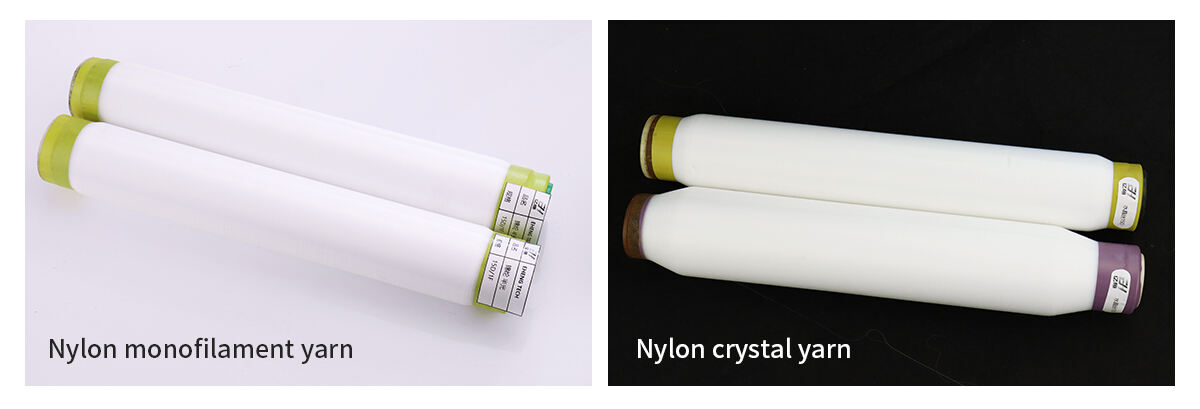In the field of high-end textile and industrial fibers, 15D/1F (15 denier/single hole) nylon fibers have attracted much attention due to their ultra-fine and high-strength characteristics. However, many buyers and manufacturers are often confused when choosing: although nylon monofilament and nylon crystal yarn have the same specifications, their performance and applications are very different. How to choose? This article will deeply analyze the core differences between the two to help you accurately match your needs.

Nylon monofilament uses traditional nylon 6 or nylon 66 as raw materials, and its production process has the following characteristics:
◇Using standard melt spinning technology, the spinning temperature is controlled at 265-280℃;
◇Through the rapid cooling process, the molecular chain forms a highly ordered crystalline structure;
◇Without special modification, the original color characteristics of nylon raw materials are maintained;
◇Multi-stage stretching is used in the production process, and the stretching ratio can reach 4.5:1
This process creates the unique performance advantages of nylon monofilament, whose crystallinity can usually reach 40-50%, which is the fundamental guarantee of its high strength.
The production of crystal yarn takes a different approach:
◇ Use special copolymer nylon raw materials to destroy the regularity of the molecular chain;
◇Use low-temperature slow cooling process to reduce the spinning temperature to 240-255℃;
◇ Add nano-level transparent agent (such as phenyl glycidyl ether);
◇ Strictly control the cooling rate to reduce the crystallinity to below 20%
"We use copolymerization modification technology to introduce side groups into the molecular chain, effectively disrupting the crystal arrangement." The technical director of Eheng New Materials Technology Co., Ltd. explained, "This is the secret of the crystal yarn's 92% light transmittance."
| Performance Indicators | Test Method | Nylon monofilament | Nylon crystal yarn | Difference rate |
| Breaking strength | ISO 13934-1 | 4.8 cN/dtex | 4.0 cN/dtex | -16.7% |
| Elongation at break | ASTM D3822 | 45% | 65% | +44.4% |
| Light transmittance | ASTM D1003 | 48% | 92% | +91.7% |
| Friction coefficient | ASTM D1894 | 0.35 | 0.28 | -20% |
| UV resistance | AATCC TM16 | 200 hours yellowing | 500 hours no change | +150% |
It is worth noting that under high temperature conditions (80°C), the strength retention rate of nylon monofilament reaches 85%, while that of crystal yarn is only 72%, which explains why monofilament is more favored in the industrial field.
In the field of medical sutures, two materials are in fierce competition:
◇ Nylon monofilament has a 60% market share in surgical sutures due to its biocompatibility and high strength;
◇ Crystal silk has emerged in endoscopic assisted surgery due to its excellent transparency;
◇ The latest research shows that modified crystal silk has unique advantages in promoting wound healing.
◇ Top sports brands use crystal silk to develop "invisible" sportswear series;
◇ Luxury brands use crystal silk for handbag dust covers, combining functionality and beauty;
◇ Innovative underwear brands launch "Second Skin" series, using 15D crystal yarn.
◇ Standard nylon chips: 2.8-3.2 USD/kg
◇ Copolymer modified nylon: 4.5-5.5 USD/kg
◇ Transparent additive cost: additional 1.2 USD/kg
·The energy consumption of crystal silk is 25% higher than that of monofilament;
◇ In terms of qualified rate, monofilament can reach 95%, while crystal silk is only 85%;
◇ Equipment depreciation cost is 40% higher.
Comprehensively, the production cost of 15D/1F crystal silk is 35-45% higher than that of monofilament, which is directly reflected in the market price.
◇ Develop ultra-high-strength varieties, aiming to break through 6.0cN/dtex;
◇ Improve temperature resistance and move towards 150℃ application scenarios;
◇ Nano-coating technology improves surface smoothness
◇ Develop self-repairing function to extend service life;
◇ Develop intelligent dimming crystal silk;
◇ Increase the proportion of recycled raw materials to meet sustainable development needs.
Industrial parts subject to mechanical stress
◇ Medical applications requiring long-term implantation
◇ Filter materials in high temperature environments
◇ Fashion products that emphasize aesthetics
◇ Packaging materials that require internal inspection
◇ Underwear that comes in direct contact with the skin
There is no difference between 15D/1F nylon monofilament and crystal yarn. The key lies in the application scenario. Industrial users give priority to the strength of monofilament, while fashion brands can use crystal yarn to increase the added value of their products.